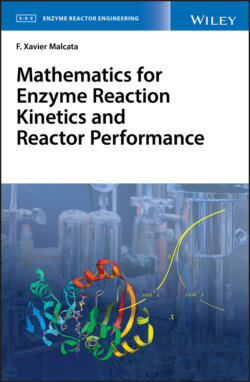Читать книгу Mathematics for Enzyme Reaction Kinetics and Reactor Performance - F. Xavier Malcata - Страница 36
2.4.3 Euler’s Form of Complex Numbers
ОглавлениеAs will be derived later, the exponential of ξ may be exactly expressed as
(2.551)
as per Taylor’s series expanded around ξ = 0; the sine of ξ may likewise appear as
(2.552)
while cos ξ abides to
(2.553)
After setting ξ ≡ ιθ, Eq. (2.551) becomes
(2.554)
– where splitting of the summation between even and odd values of k was possible based on ι2 = −1 and ι4 = 1 as algebraic rules (supporting switch between −1 and 1 along consecutive terms), and ι and ι3 = −ι (that switches between ι and −ι along consecutive terms). In view of
(2.555)
based on Eq. (2.552), and
(2.556)
stemming from Eq. (2.553), one may rewrite Eq. (2.554) as
(2.557)
– thus supporting Euler’s (exponential) form of a complex number a + ιb, as long as a2 + b2 = 1. By the same token,
(2.558)
based on Eq. (2.557) after replacing θ by −θ – where the even nature of cosine as per Eq. (2.296) and the odd nature of sine as per Eq. (2.295) allow further transformation to
(2.559)
Ordered addition of Eqs. (2.557) and (2.559) unfolds
(2.560)
whereas ordered subtraction thereof gives rise to
(2.561)
division of both sides by 2 yields
(2.562)
and
(2.563)
from Eqs. (2.560) and (2.561), respectively – or else
(2.564)
from Eq. (2.562) after combination with Eq. (2.473), as well as
(2.565)
from Eq. (2.563) following combination with Eq. (2.472). The two basic relationships between hyperbolic and circular functions are consequently conveyed by Eqs. (2.564) and (2.565).
